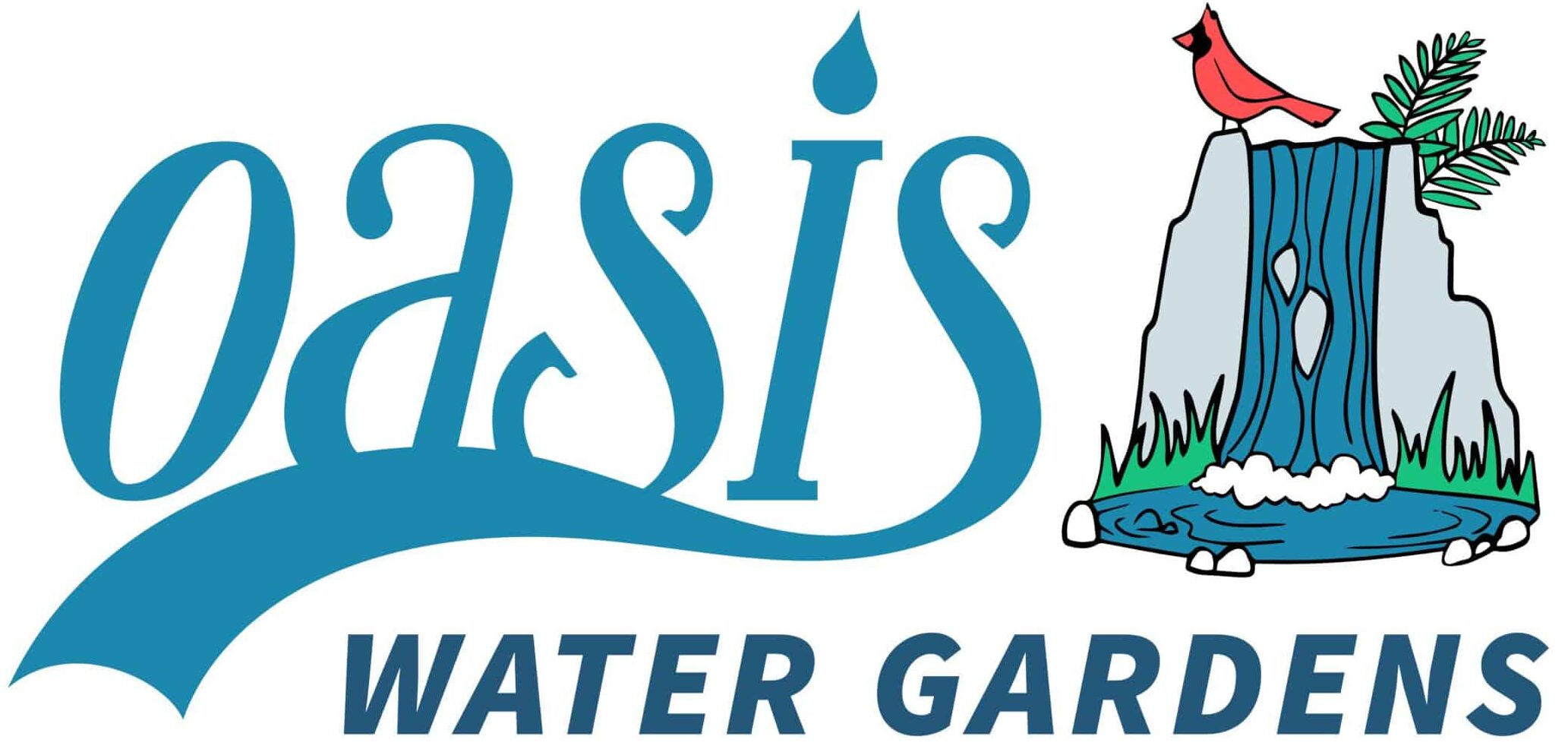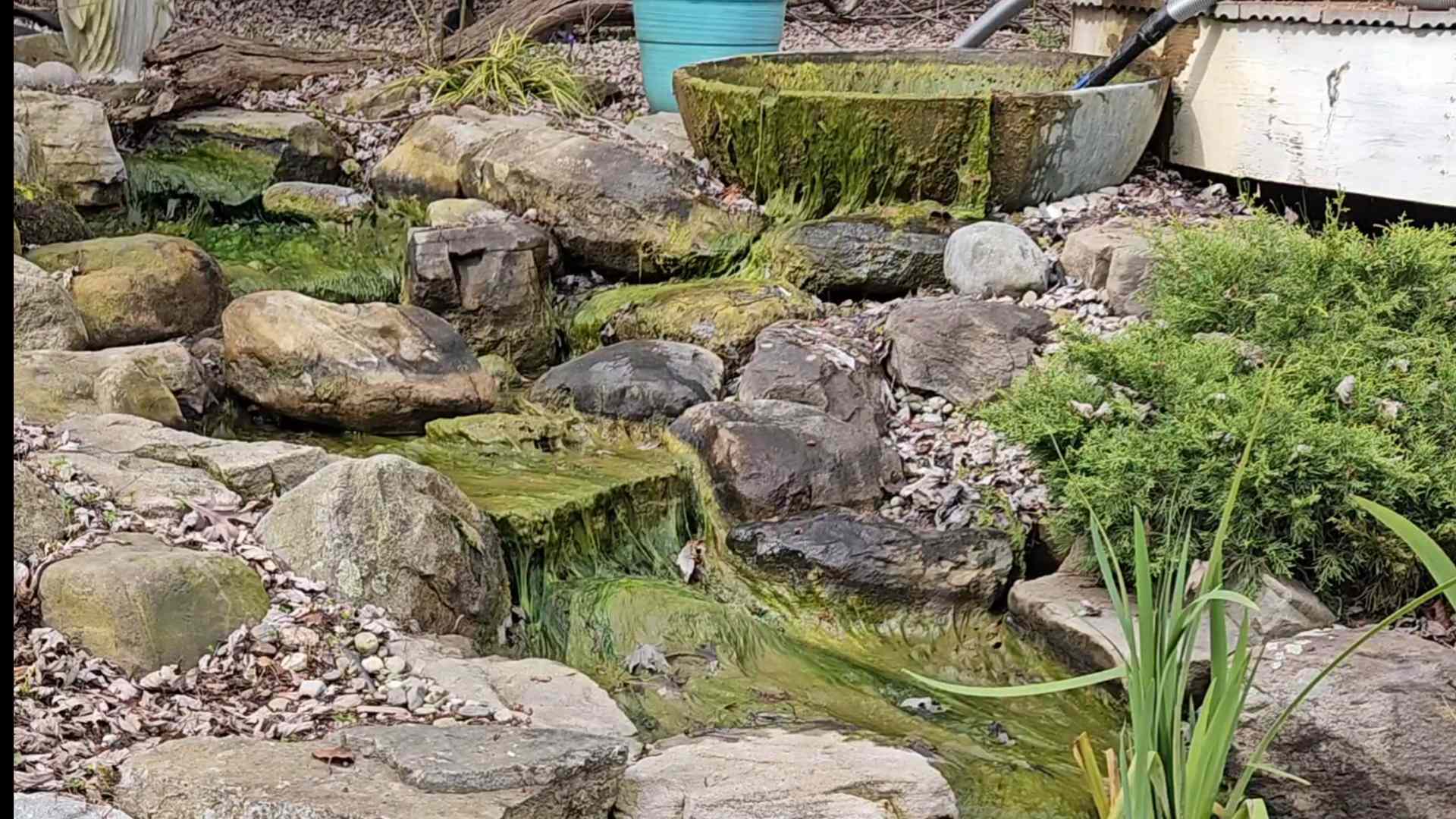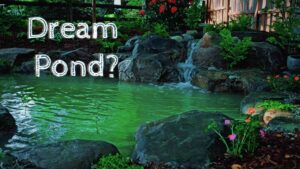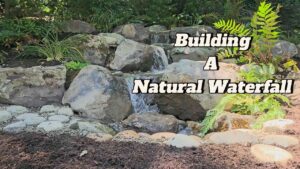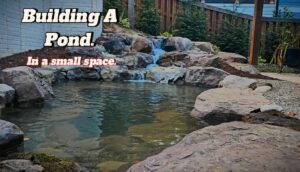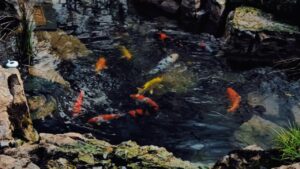String algae can be one of the most frustrating—and persistent—issues pond owners face. If you’ve ever noticed long green threads clinging to your rocks, floating mats forming in your waterfall, or slime hanging from your plants, chances are you’ve met this pesky invader.
In this post, we’ll break down what string algae is, what causes it, and how to get rid of it—the right way. Whether you’re just starting your pond journey or you’ve been battling algae for years, this guide will help you take control of your pond’s ecosystem.
Quick Definitions for Pond Owners
- Ammonia: Toxic byproduct from fish and decaying matter
- Nitrites: Also toxic to fish; an intermediate step in the cycle
- Nitrates: Plant food; harmless to fish in normal levels but loved by algae
- Phosphates: Another key nutrient for algae, introduced by decaying organic debris
Understanding the Nitrogen Cycle in Your Pond
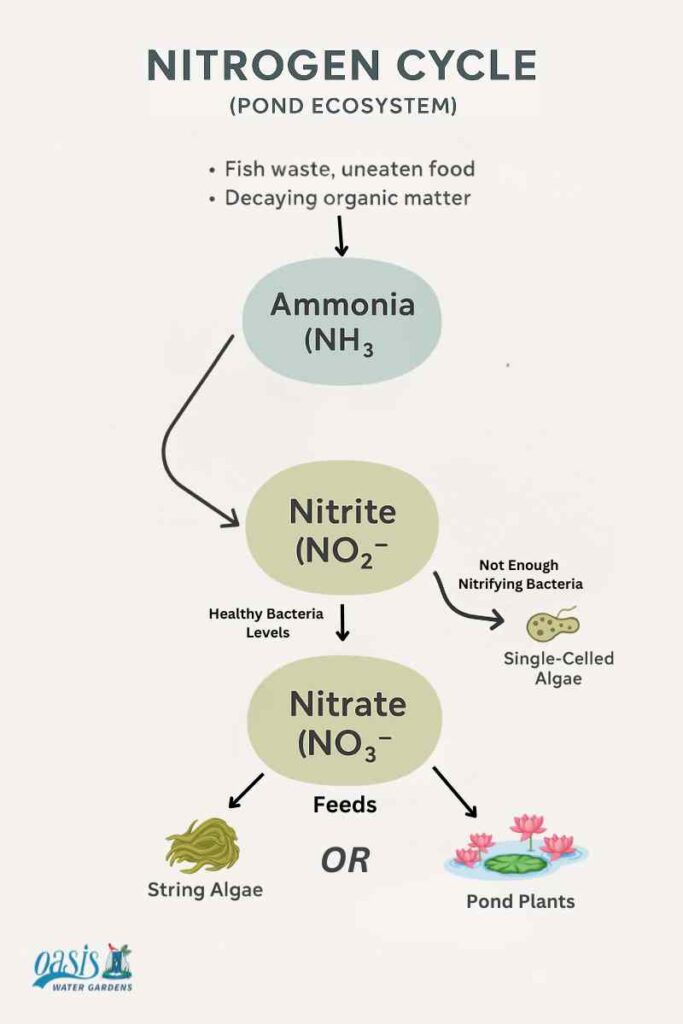
The nitrogen cycle is the foundation of every healthy pond ecosystem. It’s nature’s way of processing waste and keeping the water safe for fish and plants. When this cycle becomes unbalanced, or when key elements like plants, nitrifying bacteria or shade are missing, the system can become overwhelmed.
It All Starts Here:
- Fish naturally produce ammonia—mainly through breathing and waste, but also from uneaten food.
- Decaying organic materials like fallen leaves, dead plants, and lawn clippings also release ammonia and phosphates into the water.
- Ammonia is highly toxic to fish and must be processed by beneficial bacteria(nitrifying bacteria) in your pond.
The cycle works like this:
- Ammonia → converted by bacteria into → Nitrites
- Nitrites are also toxic to fish
- If the pond has enough nitrifying bacteria, nitrites are converted into nitrates
- If bacteria levels are too low, nitrites may instead feed single-cell algae, turning the water green (aka “pea soup” water)
- Nitrates are not immediately harmful but act as fuel for water plant growth—or for string algae
Important note:
String algae is not a sign that your pond’s nitrogen cycle is broken.
In fact, it’s a sign that it’s working well.
The presence of string algae means nitrates are being converted properly, but they’re not being used up by aquatic plants.
What About Phosphates?
While nitrates are the main byproduct of the nitrogen cycle, phosphates can also play a role in fueling algae growth.
Phosphates typically enter your pond through decaying organic matter, including:
- Fallen leaves
- Dead plants
- Twigs and grass clippings
- Uneaten fish food
As these materials break down, they release phosphates into the water—another nutrient that algae, bacteria or aquatic plants will feed on. And just like nitrates, if phosphates aren’t absorbed by pond plants or bacteria, they stick around and help fuel algae blooms.
The Role of Sunlight: The Final Ingredient in Algae Blooms
While nitrates and phosphates provide the food, sunlight provides the energy. String algae thrives in ponds that have:
- Excess nutrients(Nitrates and Phosphates)
- Consistent, direct sunlight throughout the day
Think of it like this: Nutrients provide a healthy soil, and sunlight fuels growth—just like in a garden.
If both are present in abundance, string algae grows like a weed.
If your pond gets full sun and has limited aquatic plants, you’re creating an ideal environment for algae blooms.
How to Get Rid of String Algae (The Right Way)
There are lots of “solutions” to string algae—but not all are created equal. Here’s how we rank them, starting with the most important:
#1 – SHADE: The Most Powerful String Algae Control

Just like diet is the key to weight loss, shade is the key to long-term string algae control. Without light, algae simply can’t thrive.
How to Add Shade:
- Plant trees or shrubs near the pond
- Install a pergola, umbrella, or gazebo
- Add floating plants like tropical lilies (our favorite!). Tropical lilies provide excellent shade for the pond as well as being beautiful! A must-have in any water garden.Aim to cover 50-60% of the pond with plants that provide shade for the water.
Why We Love Tropical Lilies:
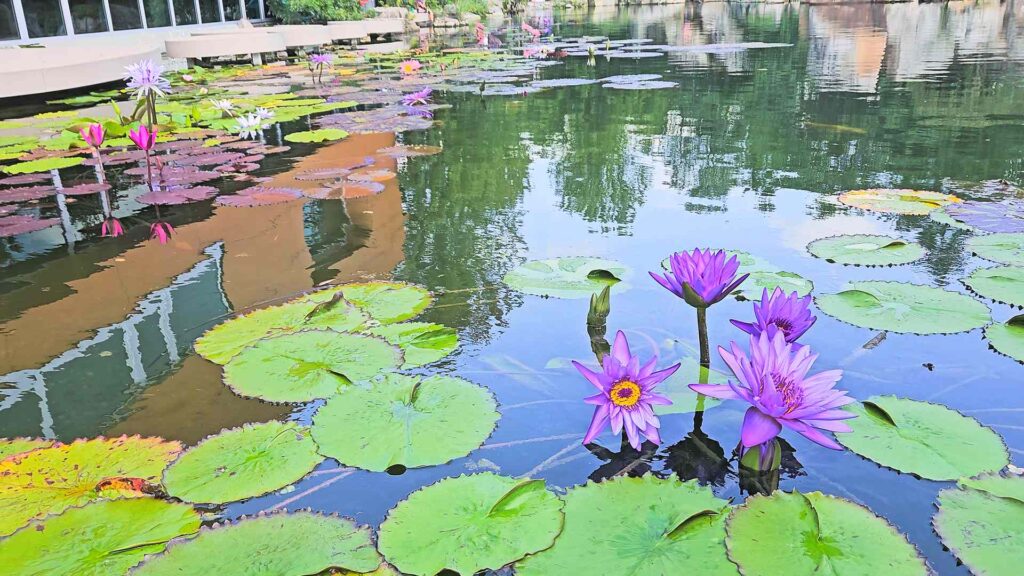
- Fast-growing and gorgeous
- Provide large surface shade
- Pull out excess nitrates and phosphates
- Work at the root of the algae problem
Pro Tip: Use fabric pots instead of plastic to avoid root-bound lilies and encourage strong, oxygen-fed root systems.
#2 – Add More Pond Plants
Plants act as natural nutrient sponges, soaking up the same nitrates and phosphates that string algae feeds on.
Here are some of our favorites:
- Tropical lilies – beautiful and effective
- Impatiens – can be planted in the rock tray of your biofalls
- Water hyacinth – great for biofilters (tie it down so it doesn’t float away!)
- Iris – These add amazing flowers and interest to the pond perimeter.
Other great options: Forget-me-nots, water mint, canna, cardinal flowers, ferns, creeping mazus, moneywort, petunias, hibiscus, sweet flag, lavender musk, and marsh marigold.
The more plant life, the fewer nutrients are left over for algae. And they make your pond look stunning. Win-win.
#3 – Aeration: Oxygen = Healthy Pond
Oxygen is one of the most important—and often overlooked—elements of a thriving pond ecosystem. High oxygen levels fuel your beneficial bacteria colonies, helping them break down excess nutrients like ammonia, nitrites, and phosphates more effectively. This directly reduces the food available to algae.
That’s why we recommend having an aerator in every pond. It doesn’t need to run 24/7, but even periodic daily use can make a big difference in your water quality. Especially at nighttime when oxygen levels drop.
Bonus: An aerator isn’t just helpful in the summer. In the winter, it can help keep a hole open in the ice, allowing harmful gases to escape and protecting your fish.
Win–win.
Our Favorite Tip:
Place an aerator directly near the pond skimmer. This draws highly oxygenated water straight into the filtration system and supercharges your beneficial bacteria.
#4 – Beneficial Bacteria
Think of beneficial bacteria as your pond’s invisible cleaning crew.
- They consume excess nutrients (phosphates, ammonia, etc.)
- They compete with algae for food
- They improve water clarity
- They break down organic sludge
The more active your bacteria, the less food is left for algae to grow. Don’t forget to add bacteria regularly—and SUPERCHARGE your bacteria with the addition of an aerator.
#5 – Water Treatments (Only After Plants & Shade)
Once you’ve established a solid base of plants and shade, then it’s time to consider treatment products.
Our Top Picks:
- Works with an autodoser or manual application
- Combines beneficial bacteria with a mild algaecide
- Supports long-term balance while tackling stubborn growth
- High concentration of enzymes + beneficial bacteria
- Breaks down debris and consumes micro-nutrients
- 100% phosphate binder (helping remove excess phosphates from the water)
- Safe for fish, pets, and plants
How to Use SAB:
- Fill a bucket with pond water (not tap water!)
- Mix in the correct SAB dosage to create a slurry
- Pour evenly around the edge of your pond
- Skim out loosened algae with a net
- Clean your skimmer often to remove floating debris
- Repeat as needed every few days
#6 – Ion Gen
The Ion Gen is a device that slowly releases copper ions into your pond. These ions target and inhibit string algae directly.
- Adjustable settings from 1–10
- Should be turned down after algae is controlled to avoid excess copper buildup
- Very effective when used properly
#7 – Barley Straw Extract
Barley straw extract can help prevent new algae growth by altering water chemistry in a way that algae doesn’t like.
- Works preventatively, not as a cure
- Extract works better than barley bales or pellets, which can rot in the pond
- Safe, natural, and low-cost
#8 – Manual Removal
Sometimes the simplest method works best. Grab a string algae rake or net and start pulling.
Just remember: remove the dead algae from the pond. If it breaks down in the water, it can become food for the next bloom.
Treatments to Avoid(Use Cautiously)
Liquid Algaecides:
- Can deplete oxygen, leading to fish suffocation
- Must be used with caution and never on hot days
- Always keep aeration running if using any algaecide
- Feeds the next algae bloom if the underlying issue is not addressed
UV Filters:
- UV light only works on free-floating algae (green water)
- String algae sticks to rocks and never passes through the UV system
- Not effective for this specific issue
- Will work to clear single cell algae, but still does not address the underlying lack of nitrifying bacteria causing the green water.
Final Thoughts
String algae is a symptom—not the root problem. The key is to address the excess nutrients and sunlight that allow it to thrive. String Algae is a sign that your Biofiltration is working properly and is harmless to the pond as long as it does not get out of control. A lot of pond owners don’t mind some sting algae in the water. Try out our suggestions until you get the balance right in your pond!
Focus first on shade and plants
Support with bacteria and aeration
Use treatments to supplement—not the first option
Written by Michael Coan
Master Certified Pond Builder & Co-Owner of Oasis Water Gardens
Helping homeowners bring natural beauty into their homes.
Serving the DMV area with expert pond and waterfall design
See our work on YouTube | Follow us on Instagram Oasis Water Gardens (@married_with_ponds)
